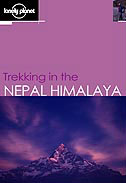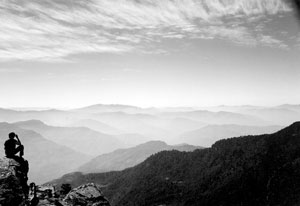 Twenty years after launching Trekking in the Nepal Himalaya, Lonely Planet guide books has brought out its much-awaited, new improved edition. After taking the book out for a field trial in the Annapurnas recently, we can say that it has been worth waiting for. The author is that walking encyclopedia of hiking in Nepal, Bhutan and Tibet, Stan Armington.
Twenty years after launching Trekking in the Nepal Himalaya, Lonely Planet guide books has brought out its much-awaited, new improved edition. After taking the book out for a field trial in the Annapurnas recently, we can say that it has been worth waiting for. The author is that walking encyclopedia of hiking in Nepal, Bhutan and Tibet, Stan Armington. Nepalis have been trekking long before tourists got here. This is a country where locomotion is mainly walking and the national motto is: Two Legs Good. We walk to the paddy terraces, we walk to collect water or fodder, to the nearest health post, we walk to and from market, we walk in marriage processions, we walk to Kathmandu to find work. And when the word "trek" entered the English lexicon from Afrikaans after Col Jimmy Roberts pioneered the first organised trek for tourists, it fit the description of trudging across the countryside in Nepal.
So what's the fun in that, one may ask Where is the amusement in climbing rough trails, staying in rustic accommodation, eating strange food? Many Nepalis are perplexed: when we walk we walk for a purpose, and yet all these foreigners wearing big boots are walking up and down our mountains-just for fun?
The stupendous scenery is of course a part of the reward. But trekking in Nepal, as Armington suggests in his book, is not just about the vast vistas. It is about the Nepali people and how the trekking trails reveal a slice of their everyday lives and bring to visitors a glimpse of an uncomplicated world far away from the mad, material rush of the 21st century. Away from the Internet, four-lane autobahns, from cities lit by halogens that blot out the stars at night. It is true, Nepal is catching up with that world, but many of the trekking trails can still be a pilgrimage of the soul.
In a little note at the beginning of the book, Lonely Planet cautions that it cannot include all nice places, and exclusion does not imply criticism. "There are a number of reasons why we might exclude a place," it goes on, "sometimes it is just inappropriate to encourage an influx of travellers." Sounds like something Leonardo di Caprio might have said about a certain lagoon in the Andaman Sea. But there you have it: the dilemma of wild and exotic places which are wild and exotic because no one knows about them yet. Should you tell the others?
Armington's new edition is full of new treks, side-treks from the main trails, places where it is worth tarrying. He has collected and incorporated suggestions of readers of the 1979 edition, like the one who stopped for breakfast at the Komrong Hilton and stayed for four days.
Most trekkers are on a tight schedule, but Armington notes that flight uncertainties and the weather can wreck the best-laid plans, so it is better to have a buffer. It is also important not to hurry past the scenery, and this is not just so you can savour the ambience. There is an important health reason: to give your body time to acclimatise. With its altitude warnings for every trek, this is a book that could quite literally save your life. (For example, it tells you that trekkers are much more prone to altitude sickness on the Gokyo trail than on the one to Everest Base Camp, and how the climb to Kyanjin Gompa may seem easy but it is a 1000 m in one day from Lama Hotel.) To show why you should not trek in a hurry, Armington quotes a cryptic conversation between two trekkers:
- "I've heard it is possible to do the Annapurna circuit in 14 days."
- "It's possible to do it in 40 days , my friend."
Armington's guide is a labour of love: riddled with factoids, small details, little things that you would never imagine were important until you got to Manang and suddenly it is a matter of great significance where the bakery is. Or, why you should never wave at a low-flying helicopter in the mountains because it may be on a rescue mission and mistake you for the group with the injured patient. Now why didn't I think of that during all these years of trekking?
 The book has other background information that is useful for trekkers: the history of trekking, ecological tips, the ethics of hiring porters, the different types of trekking and how they contribute to the local economy, and a full 12-page special section on the flora and fauna of Nepal (there are only four pages on the people of Nepal, by the way). There is also a whole medical treatise on diarrhoea, and I for one never knew there were so many different types of gastric infections. But as anyone who has got the runs during a walk will tell you: it is vitally important to know prevention and cure for the exact bug you have. Shoes, socks, a minimum equipment list, the book has all the little fine points that may look inconsequential before a trek, but take on enormous importance when you run out of dry socks on Teshi Labtsa Pass.
The book has other background information that is useful for trekkers: the history of trekking, ecological tips, the ethics of hiring porters, the different types of trekking and how they contribute to the local economy, and a full 12-page special section on the flora and fauna of Nepal (there are only four pages on the people of Nepal, by the way). There is also a whole medical treatise on diarrhoea, and I for one never knew there were so many different types of gastric infections. But as anyone who has got the runs during a walk will tell you: it is vitally important to know prevention and cure for the exact bug you have. Shoes, socks, a minimum equipment list, the book has all the little fine points that may look inconsequential before a trek, but take on enormous importance when you run out of dry socks on Teshi Labtsa Pass. The back of the book has a beginner's guide to basic trekking sentences like how to say "Is the trail steep?" in Nepali. Armington has also tried valiantly to translate some staple campfire Nepali folk songs like Resham pheeree ree. There are reader-friendly boxes scattered across the pages on subjects from leeches (dab salt on the fellows, and they'll drop off) to Maoists (you have to be more careful about khaobadis).
Westerners who are squeamish about hiring porters should take Armington's advice about being less worried about the moral dilemma of hiring someone to carry your load, and be more careful about whether they are paid and equipped adequately. (If you are paying less than $28 a day for your organised trek, he says, then the porters are probably not being paid enough.) "Using a porter is not that different than hiring a taxi in which we pay someone to drive us," Dr Raju Tuladhar is quoted as saying. The new edition also has excellent maps with contours, and even side streams marked.
Armington also shatters some myths like the over-reported story of garbage on the Everest trail. The real truth about other myths: it is possible to have a good enjoyable trek even during the rainy season. Despite what people say, you should try not to trek alone, take a guide/porter as companion for safety and also to generate local employment.
Other trivia: where to get the best tongba east of the Arun, where to buy yak heads in Manang, which police posts are less strict than others. Trekking in the Nepal Himalaya is not a guidebook, it is a trekker's bible.
Trekking in the Nepal Himalaya
Stan Armington
Lonely Planet, 2001, pp 477
approx Rs 1,500
[email protected]


